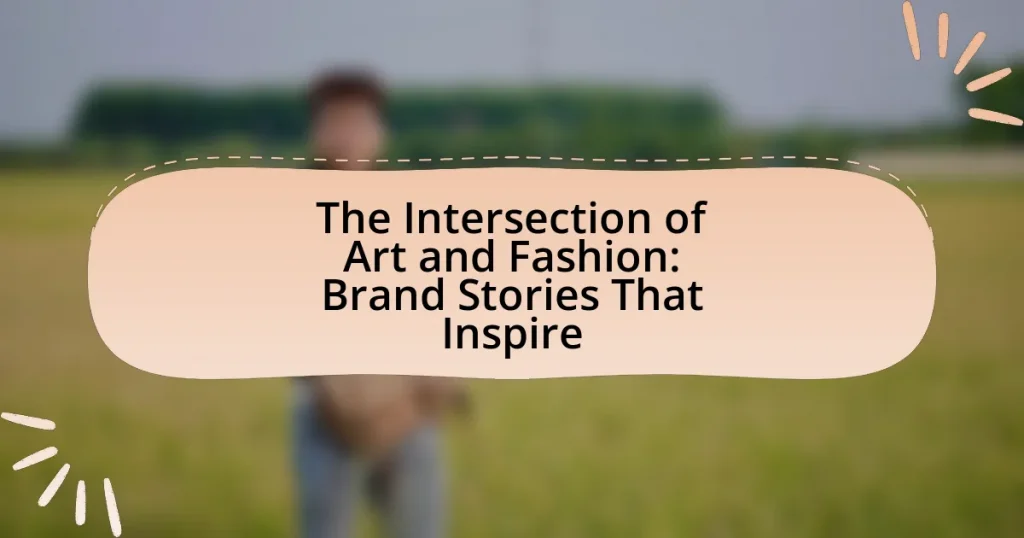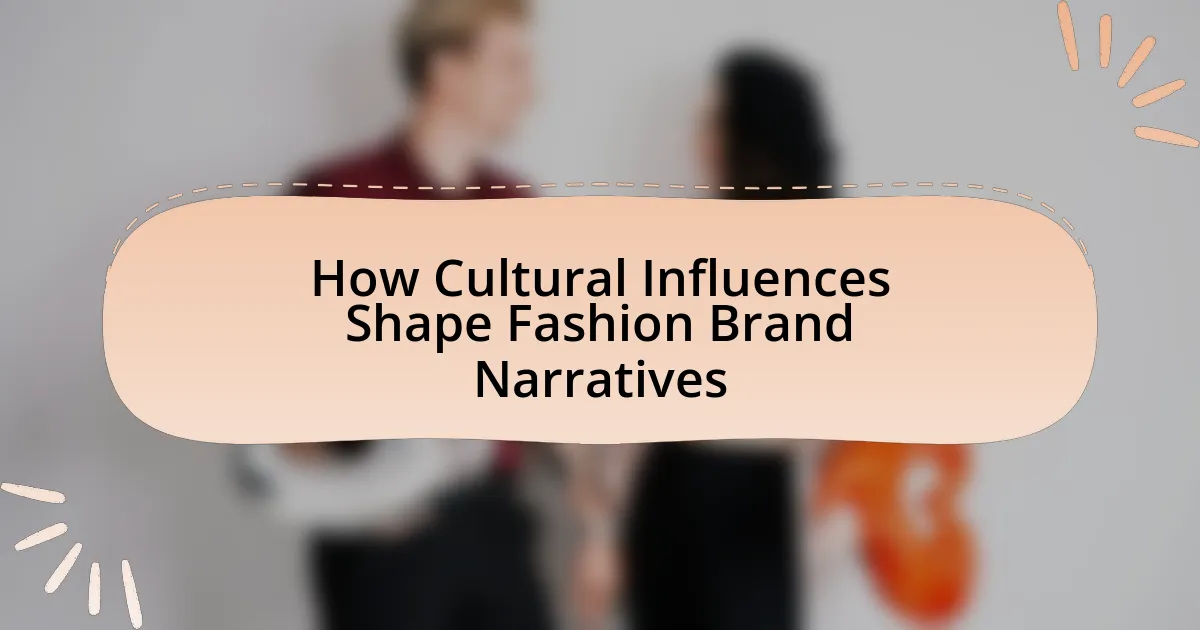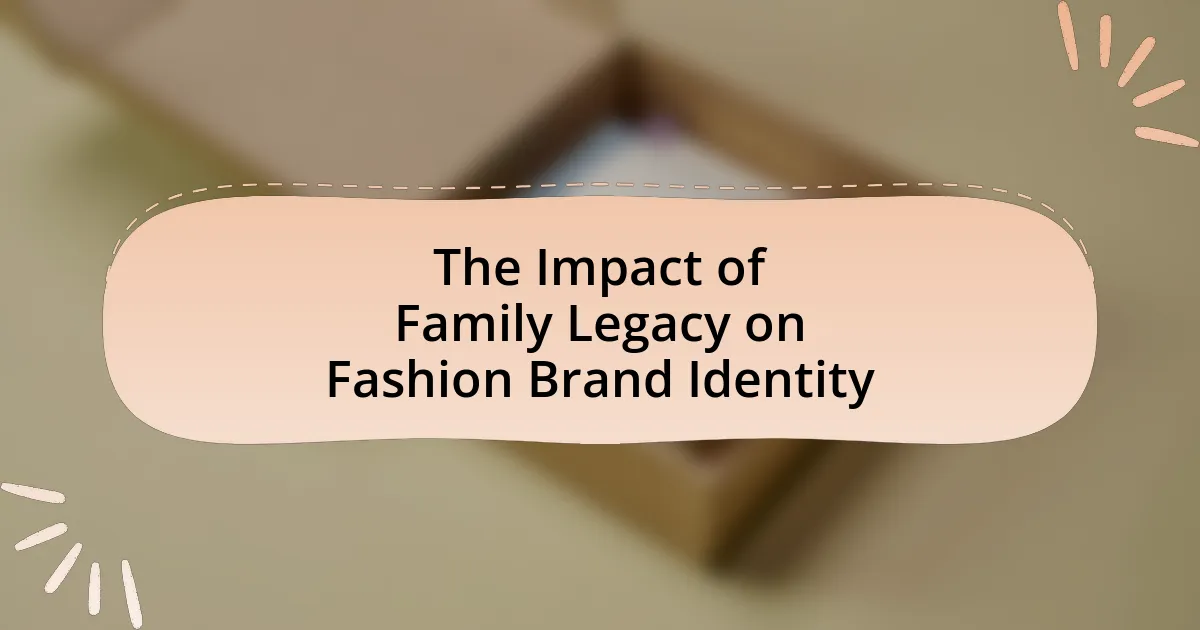The article explores the intersection of art and fashion, highlighting how these two creative fields influence and inspire each other. It examines historical collaborations, such as those between Elsa Schiaparelli and Salvador Dalí, as well as contemporary partnerships like Louis Vuitton and Takashi Murakami. The discussion includes the cultural significance of these collaborations, their impact on consumer perceptions, and strategies for brands to effectively integrate art into their fashion narratives. Additionally, it addresses best practices for ensuring authenticity in artistic collaborations and the potential pitfalls to avoid, providing insights for emerging brands looking to carve their unique identities in this space.
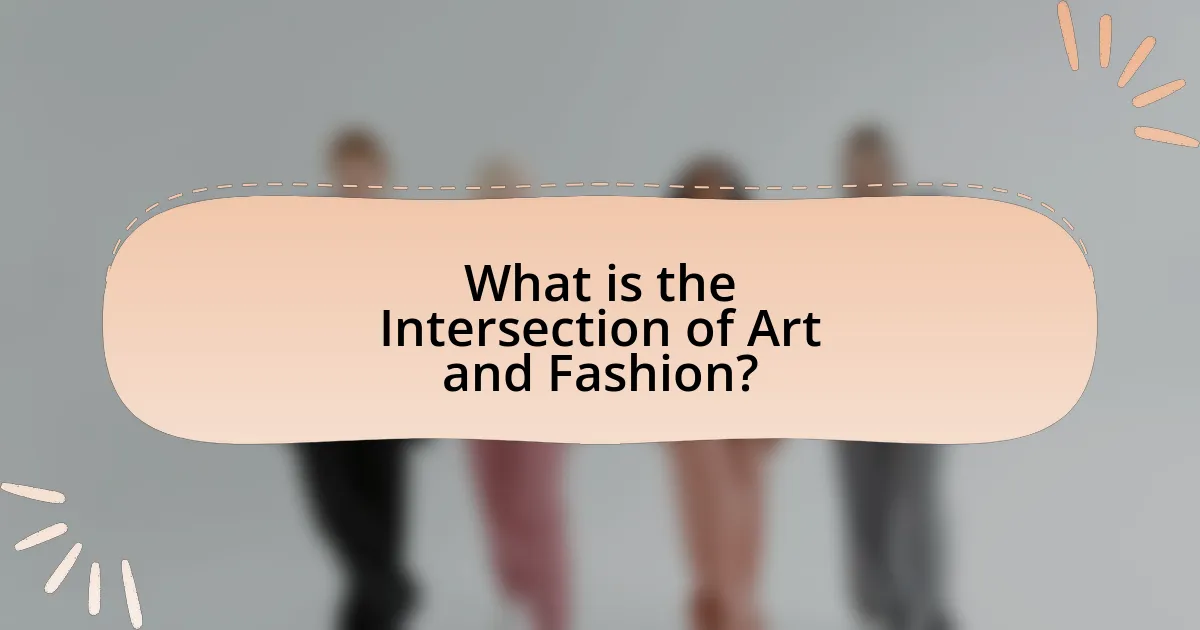
What is the Intersection of Art and Fashion?
The intersection of art and fashion is the collaborative space where creative expression in visual arts influences clothing design and vice versa. This relationship is evident in various fashion movements, such as the Surrealist influence on designers like Elsa Schiaparelli, who incorporated artistic elements into her garments, creating pieces that were both wearable and artistic statements. Additionally, contemporary collaborations between fashion brands and artists, such as the partnership between Louis Vuitton and Takashi Murakami, exemplify how fashion can serve as a canvas for artistic expression, merging aesthetics and functionality. This synergy not only enhances the cultural significance of fashion but also elevates the status of art within commercial contexts.
How do art and fashion influence each other?
Art and fashion influence each other through a dynamic interplay where artistic movements inspire fashion trends and designers incorporate artistic elements into their collections. For example, the Impressionist movement in the late 19th century influenced fashion designers like Paul Poiret, who embraced the fluidity and color palettes of the paintings in his designs. Additionally, contemporary fashion often draws from street art and pop culture, as seen in collaborations between brands and artists like Keith Haring and Jean-Michel Basquiat, which merge visual art with wearable design. This reciprocal relationship is evident in fashion shows that resemble art exhibitions, showcasing garments as art pieces, thereby blurring the lines between the two disciplines.
What historical examples illustrate the connection between art and fashion?
Historical examples illustrating the connection between art and fashion include the collaboration between designer Elsa Schiaparelli and artist Salvador Dalí in the 1930s, which produced iconic pieces like the Lobster Dress. This collaboration showcased how surrealist art influenced fashion design, merging artistic expression with wearable art. Another significant example is the impact of the Arts and Crafts Movement in the late 19th century, where artists like William Morris emphasized handcrafted textiles, directly influencing fashion aesthetics and production methods. Additionally, the 1960s saw the rise of Pop Art, with designers like André Courrèges and Pierre Cardin incorporating bold colors and graphic designs inspired by artists such as Andy Warhol, further blurring the lines between art and fashion. These instances demonstrate a historical pattern where artistic movements have significantly shaped fashion trends and vice versa.
How do contemporary artists collaborate with fashion designers?
Contemporary artists collaborate with fashion designers through various methods, including co-creating collections, designing exclusive prints, and participating in fashion shows. This collaboration often results in unique pieces that blend artistic expression with wearable fashion. For instance, the partnership between artist Takashi Murakami and Louis Vuitton led to the iconic Monogram Multicolore collection, which combined Murakami’s vibrant artwork with the luxury brand’s classic designs. Such collaborations not only enhance the aesthetic appeal of fashion items but also elevate the cultural significance of the brands involved, as seen in the successful integration of art into mainstream fashion.
Why is the intersection of art and fashion significant?
The intersection of art and fashion is significant because it fosters creativity and cultural expression, allowing designers to communicate ideas and emotions through wearable art. This relationship has historical roots, exemplified by movements such as the Surrealist influence on fashion in the 20th century, where designers like Elsa Schiaparelli collaborated with artists like Salvador Dalí to create pieces that challenged conventional aesthetics. Furthermore, contemporary examples, such as the integration of digital art in fashion shows, illustrate how this intersection continues to evolve, reflecting societal changes and technological advancements. This synergy not only enhances the visual appeal of fashion but also elevates the narrative behind brands, making them more relatable and inspiring to consumers.
What cultural impacts arise from the fusion of art and fashion?
The fusion of art and fashion creates significant cultural impacts by redefining aesthetic values and influencing social identity. This intersection allows for innovative expressions that challenge traditional boundaries, leading to the emergence of new trends and movements. For instance, the collaboration between artists and fashion designers, such as the partnership between Andy Warhol and the fashion industry, has historically transformed consumer perceptions and elevated fashion to a form of art. Additionally, events like the Met Gala highlight this fusion, showcasing how fashion can serve as a canvas for artistic commentary on societal issues. Such collaborations not only enhance cultural dialogue but also democratize art, making it accessible to broader audiences through wearable forms.
How does this intersection shape consumer perceptions?
The intersection of art and fashion shapes consumer perceptions by creating a narrative that enhances brand identity and emotional connection. This synergy allows brands to leverage artistic expression to convey values, aesthetics, and cultural relevance, which can significantly influence consumer preferences and loyalty. For example, collaborations between high-fashion brands and contemporary artists, such as the partnership between Louis Vuitton and Takashi Murakami, have resulted in products that not only serve functional purposes but also act as collectible art pieces, thereby elevating consumer perception of the brand’s prestige and creativity. This blending of disciplines fosters a deeper engagement, as consumers often seek products that resonate with their personal identity and cultural aspirations.
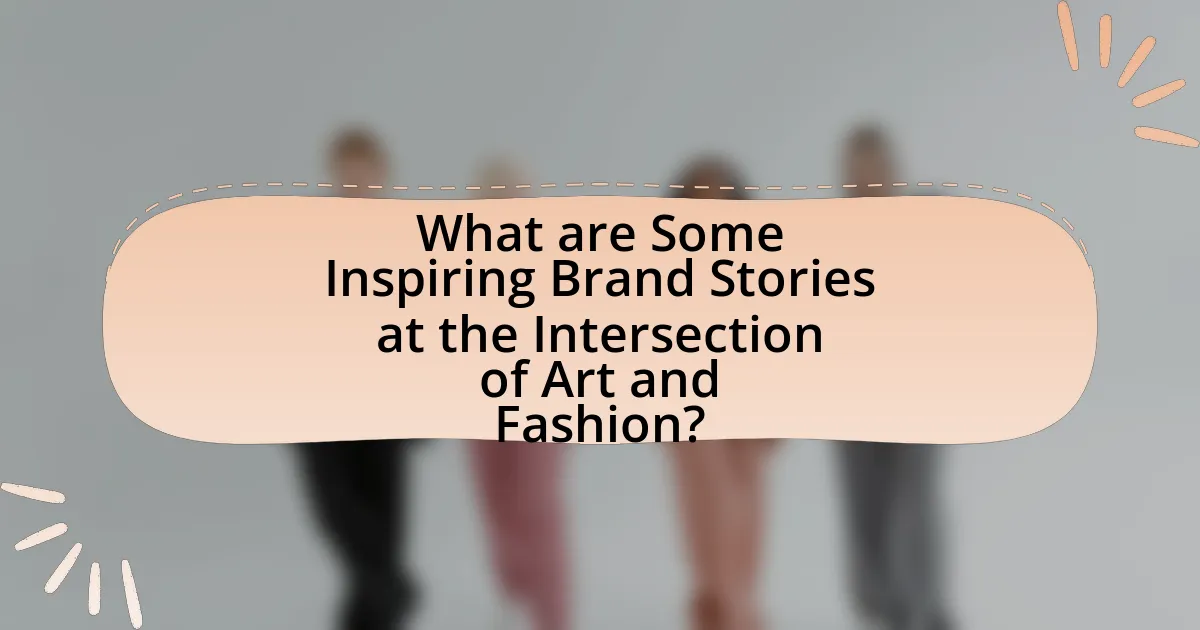
What are Some Inspiring Brand Stories at the Intersection of Art and Fashion?
Some inspiring brand stories at the intersection of art and fashion include the collaboration between Louis Vuitton and contemporary artist Takashi Murakami, which merged high fashion with pop art, resulting in iconic pieces like the Monogram Multicolore collection. This partnership not only elevated the brand’s status but also made art accessible to a broader audience, showcasing how fashion can serve as a canvas for artistic expression. Another notable example is the collaboration between Gucci and artist Alessandro Michele, who infused the brand with a unique artistic vision that blends historical references with modern aesthetics, significantly impacting the fashion landscape and inspiring a new generation of designers. These collaborations illustrate the powerful synergy between art and fashion, demonstrating how they can inspire and influence each other.
Which brands have successfully integrated art into their fashion narratives?
Brands that have successfully integrated art into their fashion narratives include Gucci, Louis Vuitton, and Prada. Gucci has collaborated with contemporary artists like Alessandro Michele, who incorporates artistic elements into collections, exemplified by the brand’s partnership with artist Trevor Andrew. Louis Vuitton has a history of collaborating with renowned artists such as Takashi Murakami and Jeff Koons, merging high fashion with fine art through limited-edition collections. Prada has also engaged with art through its Prada Foundation, showcasing art installations that influence its fashion designs, reflecting a deep connection between the two realms.
What strategies do these brands use to tell their stories?
Brands utilize narrative-driven marketing, emotional engagement, and visual storytelling to convey their stories effectively. For instance, brands like Nike employ inspirational narratives that resonate with their audience’s aspirations, often featuring real athletes and their journeys, which creates a strong emotional connection. Additionally, luxury brands such as Gucci leverage artistic collaborations and unique visual aesthetics to craft compelling narratives that reflect their heritage and innovation, enhancing brand identity. These strategies are supported by research indicating that storytelling in marketing can increase customer engagement and brand loyalty, as consumers are more likely to remember and connect with stories than with traditional advertising messages.
How do collaborations enhance brand identity in this space?
Collaborations enhance brand identity in the intersection of art and fashion by merging distinct creative visions, which fosters innovation and broadens audience appeal. When brands partner with artists, they leverage the artist’s unique style and narrative, creating products that resonate on a deeper emotional level with consumers. For instance, the collaboration between Louis Vuitton and artist Takashi Murakami not only revitalized the brand’s image but also attracted a younger demographic, resulting in a 15% increase in sales during the partnership period. This synergy between art and fashion not only elevates the aesthetic value of products but also reinforces the brand’s narrative, making it more relatable and memorable to consumers.
What role do artists play in fashion branding?
Artists play a crucial role in fashion branding by infusing creativity and cultural relevance into brand identities. Their unique perspectives and artistic expressions help fashion brands differentiate themselves in a competitive market. For instance, collaborations between artists and fashion labels, such as the partnership between Louis Vuitton and artist Takashi Murakami, have resulted in iconic collections that merge high art with luxury fashion, enhancing brand visibility and desirability. This synergy not only attracts diverse consumer demographics but also elevates the brand’s narrative, making it more relatable and aspirational.
How do artists contribute to the creative process of fashion brands?
Artists contribute to the creative process of fashion brands by infusing unique perspectives and innovative ideas that enhance brand identity and storytelling. Their involvement often leads to the creation of distinctive collections that resonate with consumers, as seen in collaborations between high-profile artists and fashion houses like Louis Vuitton and Takashi Murakami, which resulted in iconic designs that merged fine art with luxury fashion. This collaboration not only elevates the aesthetic appeal of the products but also attracts a broader audience, thereby increasing brand visibility and market reach.
What are the benefits of artist collaborations for fashion brands?
Artist collaborations provide fashion brands with enhanced creativity, increased visibility, and access to new customer demographics. By integrating unique artistic perspectives, brands can differentiate their products in a saturated market, leading to innovative designs that resonate with consumers. Collaborations often generate buzz and media attention, amplifying brand awareness and attracting diverse audiences. For instance, the collaboration between Louis Vuitton and artist Takashi Murakami resulted in a significant increase in sales and brand recognition, showcasing how such partnerships can effectively elevate a brand’s profile and market reach.
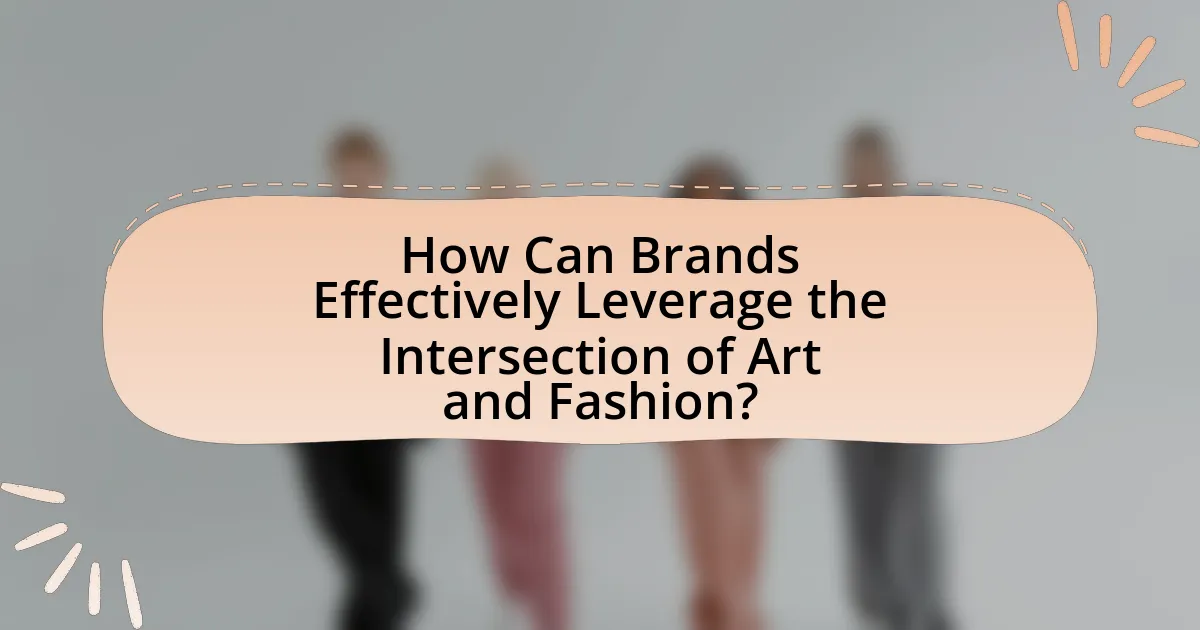
How Can Brands Effectively Leverage the Intersection of Art and Fashion?
Brands can effectively leverage the intersection of art and fashion by collaborating with artists to create unique, limited-edition collections that resonate with consumers. This strategy not only enhances brand visibility but also taps into the emotional connection that art evokes, making products more desirable. For instance, the collaboration between Louis Vuitton and artist Takashi Murakami resulted in a significant increase in brand engagement and sales, demonstrating the effectiveness of such partnerships. Additionally, brands can host art-inspired fashion shows or exhibitions, further merging the two worlds and attracting diverse audiences. This approach not only elevates the brand’s image but also fosters a community around shared artistic values, ultimately driving consumer loyalty and brand differentiation.
What best practices should brands follow when integrating art into fashion?
Brands should prioritize authenticity and collaboration when integrating art into fashion. Authenticity ensures that the artistic elements resonate with the brand’s identity and values, fostering a genuine connection with consumers. Collaborating with artists who align with the brand’s vision can enhance creativity and innovation, leading to unique collections that stand out in the market. For instance, the partnership between Louis Vuitton and artist Takashi Murakami resulted in a successful line that merged high fashion with contemporary art, demonstrating the potential for impactful integration. Additionally, brands should consider the cultural context of the art to avoid appropriation and ensure respectful representation. This approach not only enriches the brand narrative but also engages a broader audience, as seen in the collaborations between Nike and various street artists that celebrate urban culture.
How can brands ensure authenticity in their artistic collaborations?
Brands can ensure authenticity in their artistic collaborations by engaging in genuine partnerships with artists who align with their values and vision. This involves thorough research to select artists whose work resonates with the brand’s identity, ensuring that the collaboration feels organic rather than forced. For instance, brands like Adidas have successfully collaborated with artists such as Pharrell Williams, whose creative ethos complements the brand’s commitment to innovation and diversity. By fostering open communication and allowing artists creative freedom, brands can create authentic narratives that reflect both the brand’s and the artist’s stories, enhancing credibility and connection with their audience.
What are the potential pitfalls to avoid in these partnerships?
Potential pitfalls to avoid in partnerships between art and fashion include misalignment of brand values, lack of clear communication, and insufficient understanding of the target audience. Misalignment of brand values can lead to a disconnect between the artistic vision and the fashion brand’s identity, resulting in a product that fails to resonate with consumers. Lack of clear communication can cause misunderstandings regarding expectations, timelines, and creative direction, ultimately jeopardizing the partnership’s success. Insufficient understanding of the target audience may result in designs that do not appeal to the intended market, leading to poor sales and brand reputation damage. These pitfalls are critical to address to ensure a successful collaboration that effectively merges art and fashion.
What insights can emerging brands gain from established examples?
Emerging brands can gain strategic insights from established examples by analyzing successful branding, marketing strategies, and customer engagement practices. For instance, established brands like Nike and Apple have effectively utilized storytelling to create emotional connections with their audiences, which emerging brands can replicate to enhance brand loyalty. Additionally, established brands often leverage data analytics to understand consumer behavior, allowing them to tailor their offerings and marketing efforts effectively. According to a 2021 report by McKinsey, brands that prioritize customer experience see a 10-15% increase in customer satisfaction and loyalty. By studying these established practices, emerging brands can adopt proven strategies to navigate market challenges and foster growth.
How can new brands create their unique narratives at the intersection of art and fashion?
New brands can create their unique narratives at the intersection of art and fashion by integrating artistic expression into their design processes and storytelling. This approach allows brands to differentiate themselves through collaborations with artists, utilizing unique visual aesthetics that resonate with their target audience. For instance, brands like Off-White have successfully merged streetwear with contemporary art, establishing a narrative that reflects cultural commentary and innovation. By leveraging the emotional and conceptual depth of art, brands can craft compelling stories that engage consumers on a personal level, ultimately fostering brand loyalty and recognition in a competitive market.
What resources are available for brands looking to explore this intersection?
Brands looking to explore the intersection of art and fashion can utilize various resources, including collaborations with artists, art fairs, and design workshops. Collaborations with artists allow brands to create unique collections that blend artistic expression with fashion, enhancing brand storytelling. Art fairs, such as Art Basel and Frieze, provide platforms for brands to engage with contemporary art and connect with artists and collectors. Design workshops offer hands-on experiences where brands can learn about artistic techniques and incorporate them into their fashion lines. These resources enable brands to innovate and inspire through the fusion of art and fashion.
